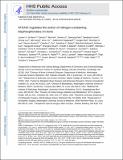| dc.contributor.author | Sabatini, David | |
| dc.date.accessioned | 2022-09-26T18:04:50Z | |
| dc.date.available | 2021-10-27T19:53:34Z | |
| dc.date.available | 2022-09-26T18:04:50Z | |
| dc.date.issued | 2020 | |
| dc.identifier.uri | https://hdl.handle.net/1721.1/133570.2 | |
| dc.description.abstract | Copyright © 2020 The Authors, some rights reserved. Nitrogen-containing bisphosphonates (N-BPs), such as alendronate, are the most widely prescribed medications for diseases involving bone, with nearly 200 million prescriptions written annually. Recently, widespread use of N-BPs has been challenged due to the risk of rare but traumatic side effects such as atypical femoral fracture (AFF) and osteonecrosis of the jaw (ONJ). N-BPs bind to and inhibit farnesyl diphosphate synthase, resulting in defects in protein prenylation. Yet, it remains poorly understood what other cellular factors might allow N-BPs to exert their pharmacological effects. Here, we performed genome-wide studies in cells and patients to identify the poorly characterized gene, ATRAID. Loss of ATRAID function results in selective resistance to N-BP–mediated loss of cell viability and the prevention of alendronate-mediated inhibition of prenylation. ATRAID is required for alendronate inhibition of osteoclast function, and ATRAID-deficient mice have impaired therapeutic responses to alendronate in both postmenopausal and senile (old age) osteoporosis models. Last, we performed exome sequencing on patients taking N-BPs that suffered ONJ or an AFF. ATRAID is one of three genes that contain rare nonsynonymous coding variants in patients with ONJ or an AFF that is also differentially expressed in poor outcome groups of patients treated with N-BPs. We functionally validated this patient variation in ATRAID as conferring cellular hypersensitivity to N-BPs. Our work adds key insight into the mechanistic action of N-BPs and the processes that might underlie differential responsiveness to N-BPs in people. | en_US |
| dc.language.iso | en | |
| dc.publisher | American Association for the Advancement of Science (AAAS) | en_US |
| dc.relation.isversionof | 10.1126/SCITRANSLMED.AAV9166 | en_US |
| dc.rights | Creative Commons Attribution-Noncommercial-Share Alike | en_US |
| dc.rights.uri | http://creativecommons.org/licenses/by-nc-sa/4.0/ | en_US |
| dc.source | PMC | en_US |
| dc.title | ATRAID regulates the action of nitrogen-containing bisphosphonates on bone | en_US |
| dc.type | Article | en_US |
| dc.contributor.department | Massachusetts Institute of Technology. Department of Biology | en_US |
| dc.contributor.department | Koch Institute for Integrative Cancer Research at MIT | en_US |
| dc.contributor.department | Whitehead Institute for Biomedical Research | en_US |
| dc.relation.journal | Science Translational Medicine | en_US |
| dc.eprint.version | Author's final manuscript | en_US |
| dc.type.uri | http://purl.org/eprint/type/JournalArticle | en_US |
| eprint.status | http://purl.org/eprint/status/PeerReviewed | en_US |
| dc.date.updated | 2021-07-23T18:49:22Z | |
| dspace.orderedauthors | Surface, LE; Burrow, DT; Li, J; Park, J; Kumar, S; Lyu, C; Song, N; Yu, Z; Rajagopal, A; Bae, Y; Lee, BH; Mumm, S; Gu, CC; Baker, JC; Mohseni, M; Sum, M; Huskey, M; Duan, S; Bijanki, VN; Civitelli, R; Gardner, MJ; McAndrew, CM; Ricci, WM; Gurnett, CA; Diemer, K; Wan, F; Costantino, CL; Shannon, KM; Raje, N; Dodson, TB; Haber, DA; Carette, JE; Varadarajan, M; Brummelkamp, TR; Birsoy, K; Sabatini, DM; Haller, G; Peterson, TR | en_US |
| dspace.date.submission | 2021-07-23T18:49:23Z | |
| mit.journal.volume | 12 | en_US |
| mit.journal.issue | 544 | en_US |
| mit.license | OPEN_ACCESS_POLICY | |
| mit.metadata.status | Publication Information Needed | en_US |
